The NVIDIA GeForce RTX 2080 Ti & RTX 2080 Founders Edition Review: Foundations For A Ray Traced Future
by Nate Oh on September 19, 2018 5:15 PM EST- Posted in
- GPUs
- Raytrace
- GeForce
- NVIDIA
- DirectX Raytracing
- Turing
- GeForce RTX
Wolfenstein II: The New Colossus (Vulkan)
id Software is popularly known for a few games involving shooting stuff until it dies, just with different 'stuff' for each one: Nazis, demons, or other players while scorning the laws of physics. Wolfenstein II is the latest of the first, the sequel of a modern reboot series developed by MachineGames and built on id Tech 6. While the tone is significantly less pulpy nowadays, the game is still a frenetic FPS at heart, succeeding DOOM as a modern Vulkan flagship title and arriving as a pure Vullkan implementation rather than the originally OpenGL DOOM.
Featuring a Nazi-occupied America of 1961, Wolfenstein II is lushly designed yet not oppressively intensive on the hardware, something that goes well with its pace of action that emerge suddenly from a level design flush with alternate historical details.
The highest quality preset, "Mein leben!", was used. Wolfenstein II also features Vega-centric GPU Culling and Rapid Packed Math, as well as Radeon-centric Deferred Rendering; in accordance with the preset, neither GPU Culling nor Deferred Rendering was enabled.
| Wolfenstein II | 1920x1080 | 2560x1440 | 3840x2160 |
| Average FPS |  |
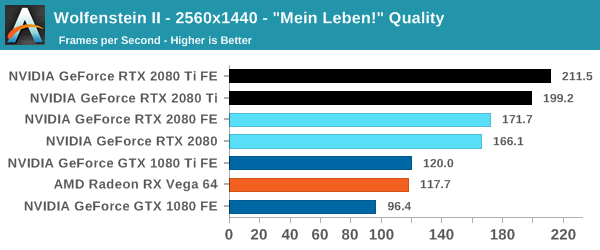 |
 |
| 99th Percentile | 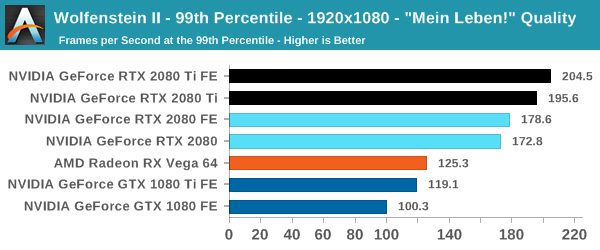 |
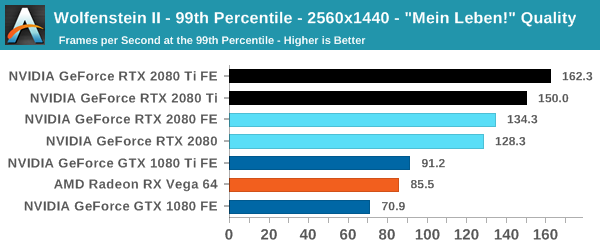 |
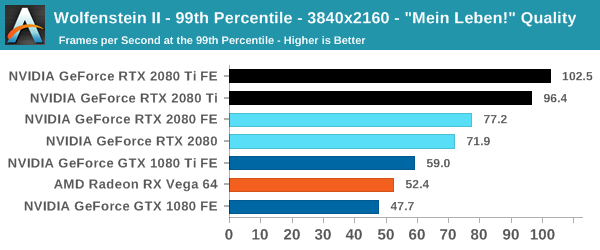 |
I am actually impressed with Wolfenstein II and its Vulkan implementation more than the absurd 250+ framerates, if only because many other games hold back the GPU because of the occurring CPU bottleneck. In DOOM, there was a hard 200fps cap because of engine/implementation limitations, a bit of a corner case, but manufacturers make 240Hz monitors nowadays, too. On a GPU performance profiling side, of course, reducing the CPU bottleneck makes comparing powerful GPUs much easier at 1080p, and with a better signal-to-noise than at 4K.
This is combined with the fact that at 4K, the 20 series are looking a huge 60 to 68% lead over the 10 series, and we'll be cross-referencing these performance deltas with other sections of the game. Even in the case of a 'flat-track bully' scenario where the 2080 Ti is running up the score, the 2080 Ti's speed compared to the 2080 is somewhat less than expected at 24 to 27%. It's a somewhat intriguing result for an optimized Vulkan game, as the game runs and scales generally well across the board; It's also not unnoticed that both the RX Vega cards and GeForce Turing cards outperform their expected positions, though without the graphics workload details it's hard to speculate with substance. With framerates like these, the 4K HDR dream at 144 Hz is a real possibility, and it would be interesting to compare with Titan V and Titan Xp results.


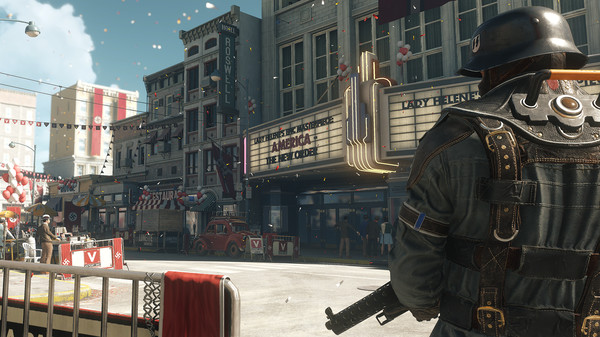









337 Comments
View All Comments
milkod2001 - Thursday, September 20, 2018 - link
NV is messing with us. Even with no competition from AMD those price hikes at such low performance gains are laughable. This generation of new GPU seems like just a stop gap before NV will have something more serious to show next year.willis936 - Thursday, September 20, 2018 - link
No they seem like they will be exactly the same as the 1000 series: they are what they are, you pay what they ask, and they will be the only decent option they offer for the next two years.Maybe if Radeon ever gets their shit together the landscape might look different in 2-3 years but trust me: for now, expect more of the same.
milkod2001 - Thursday, September 20, 2018 - link
Yeah we are pretty much getting into Intel vs AMD scenario when Intel dominates for a years and bring customers overpriced products with very slow performance upgrades. There is a hope AMD will at least try to do something about it.yhselp - Thursday, September 20, 2018 - link
The temperature and noise results are shocking. The results are much closer to what you'd expect from a blower, rather than an open-air cooler. Previous gen OEM solutions do much better than this. What's the reason for this?milkod2001 - Thursday, September 20, 2018 - link
Chips are much bigger than previous gen.iwod - Thursday, September 20, 2018 - link
I think we need DLSS and Hybrid Ray Tracing to judge whether it is worth it. At the moment, we could have the nearly double the performance of 1080Ti if we simply have a 7xxmm2 Die of it.I think the idea Nvidia had is that we have reached the plateau of Graphic Gaming. Imagine what you could do with a 7nm 7xxm2 Die of 2080Ti? Move the 4K Ultra High Quality frame rate from ~60 to 100? That is in 2019, in 2022 3nm, double that frame rate from 100 to 200?
The industry as a whole needs to figure out how to extract even more Graphics Quality with less transistors, simpler software while at the same time makes 3D design modelling easier. The graphics assets from gaming are now worth 100s to millions. Just the asset, not engine programming, network, 3D interaction etc, nothing to do with code. Just the Graphics. And Hybrid Ray tracing is an attempt to bring more quality graphics without the ever increasing cost of Engine and graphics designer simulating those effect.
What is interesting is that we will have 8 Core 5Ghz CPU and 7nm GPU next year.
Chawitsch - Thursday, September 20, 2018 - link
Given how much die space is dedicated to the new features software support will definitely be the key for these cards' success. Otherwise their price is just too high for what they offer today. Buying these cards now is somewhat of a gamble, but nVidia does have excellent relations with developers however, so support should come. As someone who would like to have a capable GPU for 100+ FPS gaming at 1440p, especially one that is future proof, I would much rather take my chances with these new cards.To me the question is this, would it really be worth focusing even more on 4k gaming, when it is a fairly niche market segment still due to monitor prices (especially ones with low latency for gaming). Arguably these high end cards are niche too, but when we can already have 4k@60 FPS, with maxed graphics settings, other considerations become more important. At any given resolution and feature level pure performance becomes meaningless after a certain point, at least for gaming. Arguing that reaching 100 FPS at 4k definitely has merit in my opinion, but by the time really good 4k monitors take over we'll get there, even with the path nVidia took.
Regarding graphics quality and transistor count, ray tracing should be a win here, if not now in the future certainly. There are diminishing returns with rasterization as you approach more realistic scenes and ray tracing makes you jump through less hoops to if you want to create a correct looking scene.
MadManMark - Thursday, September 20, 2018 - link
"I think the idea Nvidia had is that we have reached the plateau of Graphic Gaming. Imagine what you could do with a 7nm 7xxm2 Die of 2080Ti?"Yes, but that is probably why they stuck with 12nmFF actually. Note the die size, plus each card has its own GPU, rather than binned selection from the same GPU (kudos to Nate for also ruminating briefly on this in text). This means maximizing yiled is particularly important, and so begs for a mature, efficient process. TSMC achieved great things with their current 7nm process, no knock on it, but it is still UV-based, it's been long documented that there are yield challengels with that. IMO Nvidia will wait to hitch their wagons to TSMC's next process (expected next year), EUV-based 7nm+, which is expected to mitigate a lot of these yield concerns.
In other words it will be very interesting to see what the 2180 Ti looks like next year -- yes, I built a lot of assumptions into that sentence ;)
eddman - Thursday, September 20, 2018 - link
Come on, the naming is already set; 1080, 2080, 3080. What the hell is a "2180"?P.S. OCD
Lolimaster - Saturday, September 22, 2018 - link
That works if you expect graphics to be stagnant, tons of mini effects and polygon count will chunk a current 1080ti to 10fps in 2021.